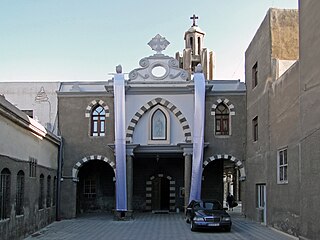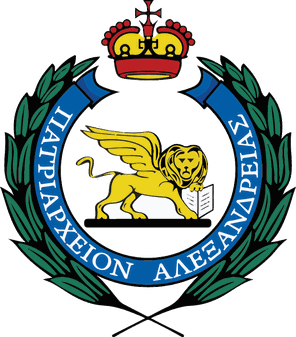
The Eastern Orthodox Church, officially the Orthodox Catholic Church, and also called the Greek Orthodox Church or simply the Orthodox Church, is the second-largest Christian church, with approximately 230 million baptised members. It operates as a communion of autocephalous churches, each governed by its bishops via local synods. The church has no central doctrinal or governmental authority analogous to the head of the Catholic Church. Nevertheless, the Ecumenical Patriarch of Constantinople is recognised by them as primus inter pares, a title formerly given to the patriarch of Rome. As one of the oldest surviving religious institutions in the world, the Eastern Orthodox Church has played an especially prominent role in the history and culture of Eastern and Southeastern Europe.

Eastern Christianity comprises Christian traditions and church families that originally developed during classical and late antiquity in Western Asia, Asia Minor, Eastern Europe, Southeastern Europe, the Caucasus, Northeast Africa, the Fertile Crescent and the Malabar coast of South Asia, and ephemerally parts of Persia, Central Asia and the Far East. The term does not describe a single communion or religious denomination.

Patriarchate is an ecclesiological term in Christianity, designating the office and jurisdiction of an ecclesiastical patriarch. According to Christian tradition three patriarchates were established by the apostles as apostolic sees in the 1st century: Rome, Antioch, and Alexandria. Constantinople was added in the 4th century and Jerusalem in the 5th century. Eventually, together, these five were recognised as the pentarchy by the Council of Chalcedon in 451.

The Syriac Catholic Church is an Eastern Catholic Christian jurisdiction originating in the Levant that uses the West Syriac Rite liturgy and has many practices and rites in common with the Syriac Orthodox Church. Being one of the twenty-three Eastern Catholic Churches, the Syriac Catholic Church is a self-governed sui iuris particular church, while it is in full communion with the Holy See and with the entirety of the Roman Catholic Church.
Greek Orthodox Church is a Christian term that can refer to any one of three classes of church, each associated in some way with Greek Christianity or the Eastern Roman Empire.

The Greek Orthodox Patriarchate of Antioch, also known as the Antiochian Orthodox Church and legally as the RūmOrthodox Patriarchate of Antioch and All the East, is an autocephalous Greek Orthodox church within the wider communion of Eastern Orthodox Christianity that originates from the historical Church of Antioch. Headed by the Greek Orthodox patriarch of Antioch, it considers itself the successor to the Christian community founded in Antioch by the Apostles Peter and Paul. It is one of the largest Christian denominations of the Middle East, alongside the Copts of Egypt and the Maronites of Lebanon.

The Antiochian Orthodox Christian Archdiocese of North America (AOCANA), often referred to in North America as simply the Antiochian Archdiocese, is the jurisdiction of the Greek Orthodox Church of Antioch in the United States and Canada. Originally under the care of the Russian Orthodox Church, the Syro-Levantine Eastern Orthodox Christian immigrants to the United States and Canada were granted their own jurisdiction under the Church of Antioch in the wake of the Bolshevik Revolution. Internal conflicts divided the Antiochian Orthodox faithful into two parallel archdioceses — those of New York and Toledo — until 1975, when Metropolitan Philip (Saliba) became the sole archbishop of the reunited Antiochian Archdiocese. By 2014, the archdiocese had grown to over 275 parish churches.

The Greek Orthodox Patriarchate of Jerusalem, also known as the Greek Orthodox Church of Jerusalem, is an autocephalous church within the wider communion of Eastern Orthodox Christianity. Established in the mid-fifth century as one of the oldest patriarchates in Christendom, it is headquartered in the Church of the Holy Sepulchre in Jerusalem and led by the patriarch of Jerusalem, currently Theophilos III. The patriarchate's ecclesiastical jurisdiction includes roughly 200,000 to 500,000 Orthodox Christians across the Holy Land in Palestine, Jordan and Israel.

The Melkite Greek Catholic Church, or Melkite Byzantine Catholic Church, is an Eastern Catholic church in full communion with the Holy See as part of the worldwide Catholic Church. Its chief pastor is Patriarch Youssef Absi, headquartered at the Cathedral of Our Lady of the Dormition in Damascus, Syria. The Melkites, who are Byzantine Rite Catholics, trace their history to the early Christians of Antioch, formerly part of Syria and now in Turkey, of the 1st century AD, where Christianity was introduced by Saint Peter.

The term Melkite, also written Melchite, refers to various Eastern Christian churches of the Byzantine Rite and their members originating in West Asia. The term comes from the common Central Semitic root m-l-k, meaning "royal", referring to the loyalty to the Byzantine emperor. The term acquired religious connotations as denominational designation for those Christians who accepted imperial religious policies, based on Christological resolutions of the Council of Chalcedon (451).

The Greek OrthodoxPatriarchate of Alexandria and all Africa, also known as the Greek Orthodox Church of Alexandria, is an autocephalous patriarchate that is part of the Eastern Orthodox Church. Its seat is in Alexandria and it has canonical responsibility for the entire African continent.
The history of the Eastern Orthodox Church is the formation, events, and transformation of the Eastern Orthodox Church through time. According to the Eastern Orthodox tradition, the history of the Eastern Orthodox Church is traced back to Jesus Christ and the Apostles. The Apostles appointed successors, known as bishops, and they in turn appointed other bishops in a process known as Apostolic succession. Over time, five Patriarchates were established to organize the Christian world, and four of these ancient patriarchates remain Orthodox today. Orthodox Christianity reached its present form in late antiquity, when the ecumenical councils were held, doctrinal disputes were resolved, the Fathers of the Church lived and wrote, and Orthodox worship practices settled into their permanent form.
Eastern Orthodoxy in North America represents adherents, religious communities, institutions and organizations of Eastern Orthodox Christianity in North America, including the United States, Canada, Mexico, Central America, and the Caribbean. Estimates of the number of Eastern Orthodox adherents in North America vary considerably depending on methodology and generally fall in range from 3 million to 6 million.

Christianity in Kuwait is a minority religion.

In 2022, Christians in Bahrain made up approximately 12% of the population. Bahrain has had a native Christian community for many centuries, with the first recorded presence dating back to the 12th century. Expatriate Christians, however, make up the majority of Christians in Bahrain, while local Christian Bahrainis make up a much smaller community. Alees Samaan, the former Bahraini ambassador to the United Kingdom, is a native Christian.

Oriental Orthodoxy is the second largest Christian denomination in Iraq after the collective Eastern Catholic Churches. It includes the Syriac Orthodox Church, headed by a patriarch in Damascus, and the Armenian Apostolic Church, which serves the population of Armenians in Iraq. A sizable population have fled from Iraq following the US invasion and subsequent conflicts. Most Oriental Orthodox Christians are of ethnic Iraqi-Assyrian heritage, who make up about 500,000. The other significant minority of Oriental Orthodox Christians are ethnic Armenians. Christians are present in Baghdad, Basra, Mosul and northern Iraq.
Eastern Orthodoxy in Jordan refers to adherents, communities and institutions of Eastern Orthodox Christianity in Jordan.

Eastern Orthodoxy in Syria represents Christians in Syria who are adherents of the Eastern Orthodox Church. The Eastern Orthodox tradition is represented in Syria by the Greek Orthodox Church of Antioch, the largest and oldest Christian community in the country.
Ghattas Hazim is a Greek Orthodox hierarch. Since 2014, he serves as Metropolitan of Baghdad, Kuwait and Dependencies, under the jurisdiction of Greek Orthodox Patriarchate of Antioch and All the East.
Constantine Papastephanou was an Eastern Orthodox hierarch and long serving (1969-2014) Metropolitan of Baghdad and Kuwait, under the jurisdiction of the Eastern Orthodox Patriarchate of Antioch and All the East.












